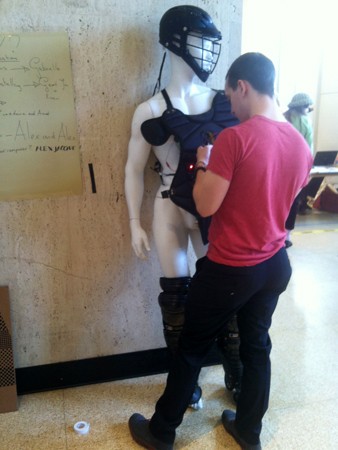How is our identity affected by the tweets, texts, posts, pings, and countless other bits of information that flow, humming ceaselessly, around our bodies? This is the question Unravel the Code, a new art exhibition at the Milton S. Eisenhower Library, seeks to explore.

Image caption: Mannequin clad in baseball catcher's gear
Image credit: Brandon Ambrosino
Unravel the Code is a collaborative, international exhibition that is the result of an exchange between Johns Hopkins, Maryland Institute College of Art, and the Willem de Kooning Academie in Rotterdam, the Netherlands.
Xiaotian Yang, a student in MICA's curatorial practice program, had the idea to transform the MSE's Q level into a professional art gallery for his thesis project. "The mission of this space," he explained, "is to showcase the diversity of the student achievements around campus," both from Johns Hopkins and MICA.
The idea for Unravel the Code comes from a course taught at MICA called International Collaboration/Wearable Technology. Kendal Ackerman, who is currently pursuing his PhD in mechanical engineering at Johns Hopkins, serves as the technical consultant for the MICA course.
"This semester," Ackerman said, "the course has been about information identity, and how the digital world interfaces, interacts with, affects the physical world." Unravel the Code, he says, seeks to analyze the interaction between virtual reality and "our ways of thinking, our physical bodies, our affect, our emotions."
An example of this kind of interface is a Facebook profile picture. "First of all," says Ackerman, "you choose the profile picture, so you're already choosing the image of yourself that you want to present to the world. It's kind of like clothing: the clothing we pick, we pick to say something about who we are. The picture we take and post on Facebook tells us something about who we are." Information, then, informs our identities.
Unravel the Code is an example of the New Aesthetic, described by London-based writer and artist James Bridle as "a series of artefacts of the heterogeneous network, which recognises differences, [and] the gaps in our overlapping but distant realities." Author Bruce Sterling offers a simpler way of looking at it in an essay written for Wired: "We're surrounded," he writes, "by systems, devices and machineries generating heaps of raw graphic novelty." What do we think about that? What do we do about that? And what do what we think and do about that say about us?
Does your head hurt? Do you feel like you're on information overload?
Guess what? You are. We all are. That's kind of the point of Unravel the Code.
"What does it mean to decipher all the information that is surrounding us?" asks Annet Cowenburg, one of the MICA faculty advisers of Unravel the Code. Cowenburg, a native of the Netherlands, says one of the principles underlying the exhibition is the belief that "we look at the digital culture in a kind of pixelated sense." (Think back to Dustin Hoffman's blanket from I Heart Huckabees: "Say this blanket represents all the matter and energy in the universe, OK?")
One of the exhibit's installations is a mannequin clad in a baseball catcher's mask and chest protector. Ackerman explains that the artwork is exploring the disconnect between an athlete playing the game in a physical world, and the detached observer watching the game on television. While the athlete completes his tasks from muscle memory, the viewer is able to supplement his experience by looking up additional information online about the player's stats, other real-time scores, correlated data from previous games, etc. Is there a way, asks Ackerman, to make some of that virtual data available to the athletes while they are playing? "And if we do that," he wonders, "how does it affect the game? Does it hinder the game? Somehow impede the muscle memory? Are you thinking too much about this information? And how does that affect things, how does it change the game?"
Sounds pretty Matrix-y. What does all this have to do with the real world?
Well, for starters, this exhibition urges us to ask what we mean when we say "real world." The lines between human reality and digital reality continue to blur—to pixelate. Unravel the Code encourages us to think about what this might mean.
Because obviously, says the mannequin in the baseball gear, it means something.
Unravel the Code runs Dec. 11-13 at MSE's Gallery Q. Admission is free and the exhibition is open to the public.
Posted in Arts+Culture








